In a perfect vermicomposting setting, you won’t encounter any pests, but that’s easier said than done. Often we see some uninvited guests in our worm bin that can get us a little worried.
Seeing an unexpected creature in a composting pile is not always a bad thing. Sometimes it can also be beneficial. However, it’s important to know about some common insects that can invade your vermicomposting bin and what you can do about it.
We can classify these creatures into three categories; the good, the okay, and the bad.
|
Good |
Okay |
Bad |
|
Millipedes |
Pot Worms |
Slugs And Snails |
|
Springtails |
Fruit Flies |
Centipedes |
|
Earwigs |
Roly Polys |
Earthworm Mites |
|
Soldier Flies |
Ants |
Let’s learn a bit more about these, so you know what to do when you encounter these.
Good Insects
These insects are most beneficial for your compost and will help in speeding up the process.
1. Millipede

The word millipedes means a thousand legs. In reality, there is no millipede or any other known organism with 1000 legs, but the millipedes do have a lot of legs. They are known by their numerous segments, with each segment having two pairs of joined legs.
These insects are quite beneficial for your compost. They are excellent decomposers and will eat up decaying plants, excrements, and insect carcasses.
A 2013 study analyzed the usage of millipedes as viable composting alternatives. The results are encouraging.
2. Springtails
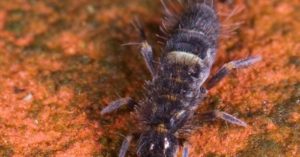
Springtails are called so because of the spring-like structure under their bellies that can elevate them into the air. These tiny wingless creatures are known to jump whenever disturbed or triggered.
They are present in compost in good numbers. In fact, springtails are one of the most abundant species on our planet.
You should not be concerned by their presence in your composting pile. They mainly feast on decomposing plants, pollens, fungi, nematodes, and droppings of other insects. They provide great assistance in composting process.
The presence of springtails indicates the composting is proceeding as it should.
3. Earwigs
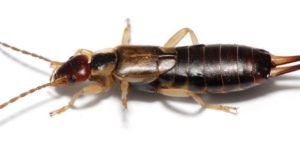
Earwigs are 0.28 to 1.97 inches long. These insects are known for their cerci, the forceps like pincers on their abdomen. If you find them in your compost, there is no need to worry. Earwigs eat mites, aphids, and other unfavorable things in your worm bin. They also feed on organic matter.
Their rear end might look dangerous, but they can’t really pinch you.
Even though they are good for compost, they are terrible for your garden. They can harm vegetables and many ornamental plants like zinnias, butterfly bush, lettuce, strawberry, potato, rose, beans, beets, corns, etc.
4. Soldier Flies
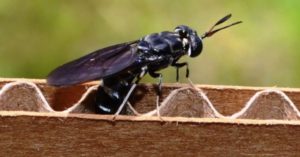
Soldier flies are mainly found near waste piles. They don’t cause any diseases or bite humans. They might lay eggs in your composting bin that can hatch into maggots.
Soldier fly maggots can speed up the composting process. They process waster even faster than worms. In fact, many people cultivate them for this purpose. You can also use maggots to feed chickens.
While some people are okay with maggots, others despise them. They will eventually grow up into flies and cause a buzz around your composting bin.
You can read more about maggots and how to get rid of them here.
Okay Insects
These insects will not hurt you or worms, but they don’t benefit your pile significantly either. In most cases, their presence indicates that there is something wrong with your compost.
1. Pot Worms

Pot worms or white worms look like baby red wigglers; however, they are different species of worms. Pot worms are not dangerous to your pile, but they thrive in conditions that are disliked by red wigglers.
You want your worm bin red wiggler friendly for the best results. White worms are generally found in wet piles. To resolve the moisture levels, dry out the pile by adding carbon-rich materials like sawdust and straw. Also, turn the pile to distribute the moisture evenly.
You can also reduce the white worm population by balancing the pH of the pile. Add some eggshells, lime, or wood ashes.
Another quick fix is to put a piece of stale bread dipped in milk on the top of the pile. The worms will accumulate around it, and you can easily remove them.
2. Fruit Flies
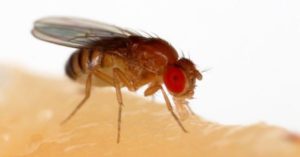
Fruit flies are not dangerous for your worms. They are incapable of biting or sting you either. However, fruit flies are not beneficial for your compost in any way.
Once you start getting them, it won’t be long before hundreds of these start swarming around your pile, and eventually, your home.
They are usually attracted to the food scraps on the top of the worm bin. So, make sure you bury the fresh scraps deep into the pile. You can buy a cheap fly trap online or built your using soap and vinegar.
3. Roly Polys

Also known as pill bugs, roly polys feed on decomposing matter. They can even speed up the process. These insects might look scary, but they don’t bite or sting.
But their presence usually indicates that the moisture level in your compost bin high. So, it’s a good idea to check that.
These insects will keep on eating decaying matter until it’s available. If they are in large quantities and there is not much decomposing matter to eat, they might start eating seedlings and vegetables on the ground. Though they will rarely invade your plants
4. Ants
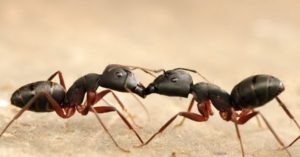
Most ants are not harmful to your bin. However, they can compete with worms for the resources and create an annoyance in the bin.
The ants in your bin can also invade your home, causing an unwarranted infestation.
The presence of ants usually indicates that your bin is dry. Check the dryness levels.
If you sprinkle cinnamon around your bin, you can avoid them. You can also create a mot around your bin, and it will prohibit them from reaching your bin.
Bad Insects
1. Slug And Snails

Slugs and snails like to feast on the decomposing matter, amongst other things. These don’t pose a direct threat to your composting pile, but they can lay eggs in it.
These eggs can spread all over your garden when you spread this compost. However, many sources point out that these can rarely survive the composting process and are often eaten by other insects.
Though most gardeners don’t like the idea of having slugs and snails lurking in their gardens, also, A big snail population can start feeding on your plants and leaves.
Please don’t use any chemical method to kill slugs; it will also kill beneficial organisms in your composting pile. Slugs are generally found on the top of your pile, where you can pick them easily. Also, their presence is an indicator that your compost is too soggy, and it’s time to dry it out.
2. Centipedes

Centipedes might resemble millipedes, but they are opposite in behavior. Centipedes have one set of legs per body segment, unlike millipedes which have two.
These are predatory insects and use toxic venom for hunting their prey. Among the creatures that they feed on are our beloved worms.
If you see them in your composting pile, you should remove them. Don’t forget to wear gloves while removing them (They Bite!)
Centipedes need moisture to survive, and their presence, therefore, indicate an overly wet pile
3. Earthworm Mites

While most worms are beneficial for a worm bin, earthworm mites are not one of them! They are considered a menace by most composters.
They wrap around decaying waste, prohibiting red wigglers from feasting on them. They are also known to kill beneficial worms. They are equipped with piercing mouth parts that are deadly for red wigglers.
They might be a little hard to distinguish. They initially emerge as white or grey clusters. If you look closely, you will be able to tell the difference.
A good way to remove them is by exposing your pile to the sun. You can also place sweet-tasting food items on the top and remove them once mites gather over them.
There is another insane method that I don’t find too appealing. You can flood the pile with water. Once the worms come on top, burn them by using a blowtorch!
Tips On Managing the Vermicomposting Pests
- Always put your worm bin in an enclosed location like your garage or basement
- Properly secure the lid but leave some way for the worms to breathe
- You can cover the bin using a breathable fabric or a mosquito net
- Do not put fresh food scraps on the top. Instead, bury these in the pile
- Crushing and freezing the scraps before adding them to the pile is also know to help
- Don’t add dairy products and meat products to your bin
- Never add pet waste into your compost bin

